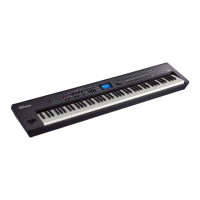Detailed Tone Settings (Designer)
Adjusting Resonance when
the Damper Pedal Is Depressed
(Sympathetic Resonance)
NOTE
This setting is available only for certain piano tones.
For details on the tones to which this applies, refer to “Sound
List” (PDF).
For details on how to obtain the PDF, refer to “Obtaining PDF
Manuals” on the front cover.
You can adjust this resonance when the damper pedal is depressed
(Sympathetic Resonance).
On an acoustic piano, holding down the damper pedal will allow
the remaining strings to resonate in sympathy with the sounds that
you played from the keyboard, adding a rich resonance. This feature
reproduces that resonance sound.
Parameter Value Explanation
Switch
OFF, ON When set to ON, the eect is applied.
Depth
0–127 Depth of the eect
Damper
0–127
Depth to which the damper pedal is pressed
(controls the resonant sound)
Pre LPF
16–15000 Hz,
BYPASS
Frequency of the lter that cuts the
high-frequency content of the input sound
(BYPASS: no cut)
Pre HPF
BYPASS, 16–15000
Hz
Frequency of the lter that cuts the
low-frequency content of the input sound
(BYPASS: no cut)
Peaking Freq
16–15000 Hz
Frequency of the lter that boosts/cuts a
specic frequency region of the input sound
Peaking Gain
-15–+15 dB
Amount of boost/cut produced by the lter
at the specied frequency region of the
input sound
Peaking Q
0.5, 1.0, 2.0,
4.0, 8.0
Width of the frequency region boosted/cut
by the Peaking Gain parameter (larger values
make the region narrower)
HF Damp Freq
16–15000 Hz,
BYPASS
Frequency at which the high-frequency
content of the resonant sound will be cut
(BYPASS: no cut)
LF Damp Freq
BYPASS, 16–15000
Hz
Frequency at which the low-frequency
content of the resonant sound will be cut
(BYPASS: no cut)
Level
0–127 Output Level
Damper Oset
0–127
Volume of additional slight resonance when
the damper pedal is not pressed
Editing the Modulation FX
(Modulation FX)
Here you can edit the modulation FX parameters.
1. While holding down the [SHIFT] button, operate the
MODULATION FX [DEPTH] (or [RATE]) knob.
The Modulation FX screen appears.
2. Select the parameter that you want to edit, and use the
[DEC] [INC] buttons or the value dial to edit the value.
Parameter Value Explanation
Type
Refer to the eect list (p. 58).
Species the type of Modulation FX.
The editable parameters will depend on
the eect type that’s selected.
Parameter Value Explanation
Routing
MOD FX (Modulation FX)
g TR/AMP (Tremolo/Amp
Simulator)
TR/AMP (Tremolo/Amp
Simulator) g MOD FX
(Modulation FX)
Lets you select the routing of the
Modulation FX and the Tremolo/Amp
Simulator.
By switching the Routing type, you can
change the eect that’s applied to the
sound.
For example, suppose that you chose
Chorus as the MOD FX and chose
E.PIANO for TR/AMP; with the MOD FX
g TR/AMP setting, the chorus sound will
be output in monaural, but with the TR/
AMP g MOD FX setting it will be output
in stereo.
Switch
OFF, ON Turns the Modulation FX on/o.
MEMO
For details, refer to “Eect List” (p. 58) and “Eect Parameter Guide”
(PDF).
For details on how to obtain the PDF, refer to “Obtaining PDF
Manuals” on the front cover.
Editing Tremolo/Amp Simulator
(Tremolo/Amp Simulator)
Here’s how to edit the Tremolo/Amp Simulator parameters.
1. While holding down the [SHIFT] button, operate the
TREMOLO/AMP SIM [DEPTH] (or [RATE]) knob.
The Tremolo/Amp Simulator screen appears.
2. Select the parameter that you want to edit, and use the
[DEC] [INC] buttons or the value dial to edit the value.
Parameter Value Explanation
Type
Refer to t”Tremolo/Amp
simulator types” (p. 35)
Selects the type of Tremolo/Amp
Simulator.
The editable parameters will depend on
the eect type that’s selected.
Routing
MOD FX (Modulation FX)
g TR/AMP (Tremolo/Amp
Simulator)
TR/AMP (Tremolo/Amp
Simulator) g MOD FX
(Modulation FX)
Lets you select the routing of the
Modulation FX and the Tremolo/Amp
Simulator.
By switching the Routing type, you
can change the eect that’s applied to
the sound.
For example, suppose that you chose
Chorus as the MOD FX and chose
E.PIANO for TR/AMP; with the MOD FX
g TR/AMP setting the chorus sound will
be output in monaural, but with the TR/
AMP g MOD FX setting it will be output
in stereo.
Tremolo/Amp simulator types
Type Explanation
1
NORMAL
This is an amp with a at frequency response. It allows you to
add a tremolo eect and distortion.
2
A.PIANO
In addition to NORMAL, this reproduces the open/closed state
of a grand piano’s lid.
35

